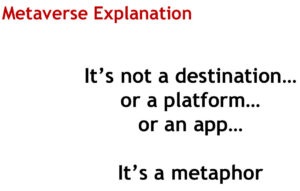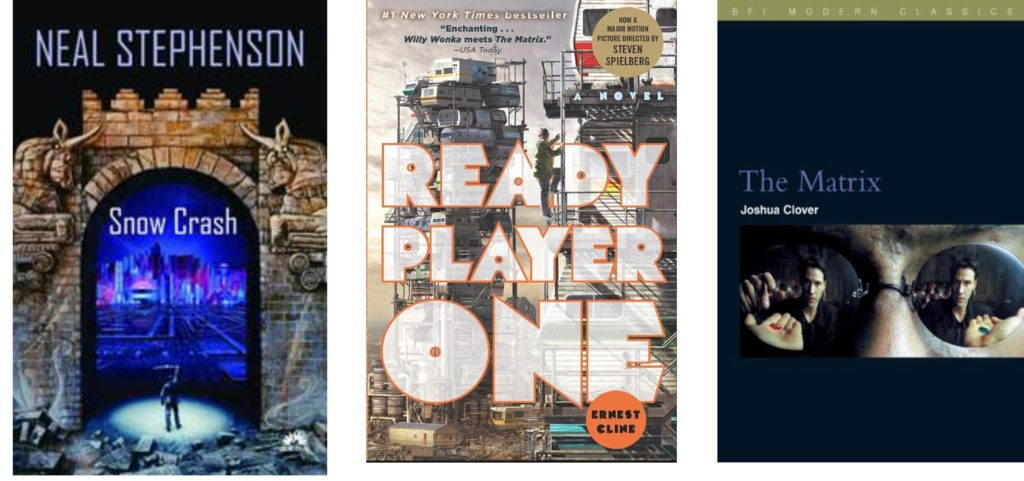Questions (and answers) abound, but many are antithetical at this point.

What is the metaverse? If you ask 10 people, you are more likely than not to get 10 different answers.
There is no metaverse—there will never be a metaverse. There are dozens of metaverses and soon probably hundreds. Which view you hold depends on the definition of what a metaverse is, and we repeat: There is no definition—there are several definitions.
Where everyone and everything can interact seamlessly across physical and virtual worlds.
The concept of a metaverse is developing, and there are many definitions of what it is.
The metaverse is the next big thing, but it’s still very much in the process of becoming. At JPR, we’ve been watching 3D technologies grow and improve thanks to industries such as gaming, entertainment content creation, industrial CAD, architectural design, and scientific research. Most of all, the emergence of game engines has provided a structure for building programmable 3D environments, which can be used to tell stories, get work done, and explore ideas.
The idea of a metaverse has been around as long as the computer has, but the idea of a shared alternative reality has been a dream of humanity since the beginning of imagination and the reality of hardship. However, few people believe in anything like the metaverse. Rather, it’s more like many immersive 3D worlds with varying degrees of immersion, interactivity, and interoperability. That is a more interesting idea because we’re seeing gaming worlds like Fortnite or World of Warcraft develop, along with children’s playscapes like Minecraft, adult playscapes, interactive movies, and on and on in an ever-lengthening, genre-defying list. Alongside those worlds born of gaming, we’re seeing what JPR calls the industrial metaverse, which is where architectural walkthroughs and digital twins become valuable repositories of design, including past design decisions.
My definition for any metaverse is that it has the following components:
- A virtual 3D world viewable on a variety of client devices (e.g., augmented-reality glasses and smartphones, computer monitors, virtual-reality headsets, Cave Automatic Virtual Environments [CAVEs], and video display walls and projectors).
- A distributed ledger system (i.e., blockchain), currently associated with Web3. Why? Because the use of a distributed ledger system puts the users in charge instead of management.
- A borderless token exchange system that includes moving tokens frictionlessly between metaverses (this could include non-fungible tokens).
- Avatar creation by users (which raises the issue of freedom of speech and decency issues concerning how far one can use their imagination to create such avatars—lessons learned from Second Life, as an example).
- Asset transfer, or the ability to take an asset won or bought in one metaverse and move it to metaverse n—an important aspect of metaverse interoperability.
- A strategy for data exchange, such as standard formats. World builders—organizations like and including game developers—are needed to build open worlds and accommodate construction within the world by users. This is where virtual real estate and distributed ledgers come into play. Advertisers want to erect billboards near virtual events or within games; people want to buy and sell all sorts of things, including real estate.
- Support for software tools such as 3D modeling and AI training, targeting AR for single-lens 3D creation and simultaneous localization and mapping, or SLAM.
- The servers, networks (connection to the real-world components, i.e., sensors), massive storage systems, and other Internet plumbing must be in place and available to all, including very high-speed Internet and very low-latency applications.
- Security, privacy, safety, and ethics protocols.
Interoperability is critical to the metaverse concept, and we’re seeing it develop slowly and in fits and starts. The efforts going into standards bodies and forums suggest a way forward, and in fact, at Siggraph 2022, the Metaverse Standards Forum made its debut to bring all the interested parties together. Just as propitious, Khronos and the Academy Software Foundation will work together more effectively without duplicating effort. Developing metaverse technologies demands standards and collaborative standards bodies.
Today, there are several 3D worlds in which interchange of assets, tokens and NFTs, files, and interactivity can take place—but they are closed gardens, private and parochial. Some examples are Fortnight, Minecraft, Voxels, and Omniverse. The engineering world is driving toward its own idea of private metaverses with digital twins, smart cities, and smart infrastructure facilities such as plants.
Suppose the term “metaverse” gets applied to the existing 3D platforms. In that case, I see the taxonomy of verses as shown in the image below.

Based on one or a few elemental standards, the platforms operate well. Nvidia’s Omniverse, for example, is based on Pixar’s Universal Scene Description (USD). Within the Nvidia Omniverse platform, people can work collaboratively across multiple disparate applications and exchange 3D assets quickly and smoothly—worldwide. Pixar has released USD as open source. At Siggraph 2022, Nvidia talked about the ways in which it wants to extend USD beyond its primary application for entertainment content creation to other applications including engineering and architecture.
Also at this year’s Siggraph, Nvidia discussed making its Omniverse tools available to everyone via the cloud. Previously, Nvidia’s Omniverse was accessed only through RTX-equipped laptops, desktops, or workstations. Omniverse breaks the traditional, linear, stepwise development and production pipeline, transforming it into an open, free-form, interactive collaboration field.

Fortnight, Minecraft, and others rely on HTML and various APIs to provide their interactivity. But you can’t exchange assets from Fortnight with Minecraft or any other platform, and you probably never will. Nor can you exchange assets from Omniverse Fortnight or Minecraft, but Nvidia and Unreal have collaborated on Omniverse Connectors for USD and Material Definition Language (MDL) content, so there is work headed in that direction.
In fact, the companies most interested in building the metaverse have allied to form the Metaverse Standards Forum. The group includes Khronos, the developers of Vulkan and other industry-standard APIs; Autodesk; Adobe; Esri; Meta; Nvidia; Sony Interactive Entertainment; Unity; and many more in a long list have joined the organization to bring some of the existing standards they and others have developed to the metaverse to define and stabilize it. Notable organizations include the Academy Software Foundation (ASWF), Web3D Consortium, and W3C Virtual World Society.
The daunting list of members and participants can be found on the Metaverse standards Web site run by Khronos.
Khronos also announced the adoption of its glTF by ISO, IEC, and JTC. A file exchange mechanism and API-neutral runtime asset delivery format, glTF bridges the gap between 3D content creation tools and modern graphics applications. It includes properties such as 3D motion as well as rendering and placement.
Khronos offers its definition of the metaverse.

Another popular description of the metaverse is offered by Tony Parisi, the co-creator of VRML and glTF.
- Rule #1. There is only one metaverse.
- Rule #2: The metaverse is for everyone.
- Rule #3: Nobody controls the metaverse.
- Rule #4: The metaverse is open.
- Rule #5: The metaverse is hardware-independent.
- Rule #6: The metaverse is a network.
- Rule #7: The metaverse is the Internet.
I think the primary gateway to the metaverse will be the smartphone. Everyone already has one and knows how to use it. The smartphone is already a central AR platform, and dozens of sites and apps support AR experiences; it’s not just about Pokémon.
The allure of the metaverse is that we will be able to transcend our physical world, “teleport” to any place, real or imaginary, and have an enjoyable, educational, or practical experience there. It will be a place to work as well as play.
The metaverse will probably continue to be an ongoing development and will never be fully defined or become fixed. Like many other things in life, it will be a different experience for different people. Some will use it to go to a museum or church, or visit relatives, when such an excursion is physically impossible for them. Some will visit past relatives and aliens in other worlds. Some will, as they do now in Second Life, adopt other personas. Things in the metaverse can be owned like real estate and NFTs.
Like the technology underpinning it and the human communities building it, the metaverse is ever evolving. As with many new technologies and concepts, the wise observer describes it as anything you want or can imagine it to be.
What will your metaverse be?






